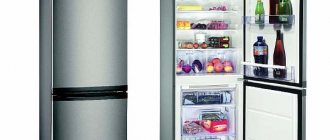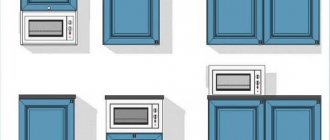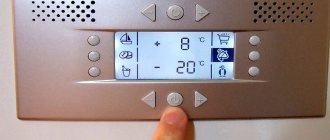Difficulty in dealing with greasy drops on the walls of the refrigerator
Another minus. At first it seems: what’s wrong with that? I’ll cook it and immediately wipe off the splashes. But, as always happens, you immediately become too lazy to wipe it off, the drops dry up tightly, and then look ugly against the backdrop of the snow-white side of the refrigerator...
But getting rid of them is now not so easy, because the delicate enamel of the refrigerator is not like a ceramic “apron” on the wall, and it will not withstand friction with an iron brush.
In general, you will have to keep an eye on this matter all the time and do not forget to wipe it right away. And this is no longer good, it’s annoying.
Of course, if you have absolutely no other way to place the elements, then we will tell you how to protect the refrigerator from grease. But, nevertheless, we insist that you think carefully again.
How to make thermal insulation?
Despite many prohibitions and contraindications, the refrigerator can still be beautifully integrated into the overall interior of the kitchen without harming its operation. Today, there are many modern technologies that will minimize the harm of the “neighborhood” of this device in the kitchen with other heating equipment. To safely isolate devices from each other, it is enough to separate them securely. To do this, you can lay thermal insulation. This is good protection that allows you to isolate the refrigerator from other equipment, as well as close its walls from all kinds of contaminants.
Despite the huge choice of technologies, there is no universal material for thermal insulation. Attaching protective sheets requires not only time, but also money, and replacing thermal insulation is labor-intensive. This is the main disadvantage of its installation. Materials for thermal protection are divided into inorganic and organic:
Organic materials include cork sheets, textolite, reeds, chipboard and polystyrene foam
The main advantage of such insulation is non-toxicity, which is very important for high temperatures. In addition, this raw material is resistant to moisture
The disadvantage of using organic insulation is deformation during the heating process and high cost.
Inorganic materials include mineral fiber, drywall and fiberglass. Such raw materials are affordable, withstand temperature changes well, but are not resistant to moisture. When installing inorganic insulation, it is recommended to use double-sided tape as fastening. It holds the sheets securely and is easy to remove.
Thermal insulation is sold in the form of edged sheets 75 centimeters wide and about 5 millimeters thick, as well as in rolls. The outer side of the material is covered with a special lavsan film, and the inner side is self-adhesive. Before starting pasting, it is recommended to lay the sheets on the floor so that they straighten. Then you can get to work. The sticker is applied to the refrigerator wall along the entire height from top to bottom. It is necessary to leave a distance of about 2 centimeters at the back of the device, this is necessary for air circulation of the condenser. The gluing process itself takes a few minutes.
17photos
How to attach insulation?
When installing a thermal insulation sheet, do not forget about the aesthetic side of the issue. For example, the edge of a chipboard without facing does not look very attractive: shavings of different sizes and a rough surface immediately catch the eye. Therefore, the end of the sheet must be covered with a decorative film, laminated or hidden with a suitable profile.
It’s also not worth fixing the sheet “forever” with liquid nails or glue. Circumstances may change and, perhaps, in a couple of years it will be necessary to rearrange the equipment so that the sides remain open.
The best option is double-sided tape attached to the wall of the refrigerator, the adhesive layer of which will securely hold the insulation sheet. If necessary, it will be easy to remove without leaving a trace. You should not attach the sheet to the stove - when heated, the adhesive tape loses its adhesive properties and ceases to hold the insulation.
How to separate a refrigerator from a gas stove?
If there is a recommended gap, the latter can be used for placement inside the cabinet. Inside you can place all sorts of little things for storage. The unit will receive additional protection from negative factors. But there are other solutions that are acceptable for this situation.
Protection using chipboard
Plates made from various materials are already quite rigid, so they do not require additional fastening. Chipboard is one of the modern materials used in the manufacture of such parts. It is recommended to place laminated sheets between the refrigerator and the stove; they have better characteristics compared to other bases. Decorative film is used to cover the cuts.
Tile screens
The practicality of such protective screens is higher than the previous version due to the following properties:
- Easier cleaning.
- Harmonious and attractive appearance.
You may be interested in: Is it possible to hide a refrigerator?
In the case of the manufacture of this type of protection, it is recommended to use OSB rather than chipboard. Then the glued tile will adhere more securely to the base used. The main thing is to carefully seal the cracks located between the tiles. Then moisture does not penetrate into the inner layers of drywall.
Barriers with foil or glass
Foil or mirror have always been classified as materials capable of absorbing heat and sunlight in large quantities. Compared to other materials, such partitions can be thinner. If mirror reflections are not entirely appropriate, you can remove this effect using so-called corrugated glass.
What to put between the gas stove and the refrigerator
Below is a list of materials that can be used to protect your refrigerator. Ideal for a gas stove:
- Expanded polystyrene;
- Foil thermal insulation;
- Drywall;
- OSB;
- Folding thermal screen for gas stove;
- Thermal screen for refrigerator with magnets.
Please note that thermal insulation with aluminum foil must be non-flammable. There are cheap options, they are intended only for insulation. They are not suitable for you - there is a risk of fire. It’s better to play it safe and pay a little more, but prevent the insulation from catching fire.
OSB board is an excellent option in terms of decoration. You can stick tiles on it, and it will become an extension of the kitchen apron. This way you will simultaneously protect the refrigerator and add some zest to the interior. Alternatively, you can cover it with aluminum foil.
To protect a refrigerator standing next to an electric stove, the following are ideal:
- Foil thermal insulation;
- chipboard;
- LDSP (laminated chipboard);
- Thermal screen for refrigerator with magnets;
- Drywall.
Important
On the Internet, in forums, some recommend using asbestos boards. Under no circumstances should you do this! Asbestos is harmful to health and causes cancer of the lungs, larynx, ovaries, etc.
Thermal insulation plates for refrigerators with magnets.
Is it possible to place a refrigerator next to a gas pipe, what will a specialist say?
It is well known that it is not recommended to place the refrigerator next to objects that emit heat: heating radiators, ovens and hobs. It is clear that if there is a gas stove in the kitchen, the refrigerator should be located at a remote distance from it, but is it possible to place the refrigerator next to the gas pipe?
To answer this question, you should consider the risk factors that arise during the operation of the refrigerator and correlate their danger when exposed to the gas pipeline.
Refrigerator operating principle and risk factors
The refrigerator works by extracting heat from the refrigeration chamber by passing through it a cold liquid refrigerant (freon), which evaporates when thermal energy is taken. Then following the condenser system of the refrigerator in the form of a thin serpentine tube on the back wall, the freon gas cools, releasing heat to the environment.
The refrigerant enters the compressor in the form of condensate, after which it is compressed (at the same time its temperature becomes below zero) and supplied to the refrigeration chamber in a liquid state.
The compressor itself operates from an alternating current network and is an electric motor, on the shaft of which there is a special type of nozzle that compresses the freon condensate entering the working chamber.
Thus, there are two factors that present some risk when operating a refrigerator: the warm surface of the condenser coil on the back wall and the electrical supply to the compressor.
Rice. 1 Refrigerator in the kitchen - examples of location
Is it possible to place a refrigerator next to a gas pipe - an expert's answer
If measurement is not possible, the temperature on the back wall of the refrigerator can be calculated in a simple way: it consists of the sum of the room temperature and the difference between the ambient temperature and the air in the refrigerator compartment. Thus, with the warmest air in the kitchen being 25 degrees, this value will not exceed 55 - 58 degrees (in practice, taking into account losses of 50 degrees, this is the maximum value).
Considering that the back wall of the refrigerator is usually located at a minimum distance of 20 - 30 mm. from the pipe, this factor will not affect the gas pipeline system in any way, even if it is tightly connected to the pipe and the temperature is several times higher.
The second risk factor is the presence of an electric compressor power cable with an alternating voltage of 220 volts in the gas pipe area. Here it may seem to an ignorant person that if the cable breaks or other malfunctions, current will flow into the pipe, a spark will ignite and an explosion will occur. This assumption is groundless for the following reasons:
- The gas pipeline pipes are made of metal and go into the ground, so when they come into contact with the electric drive, the phase will be grounded, and if the machine does not turn off the electricity in the apartment, the gas pipe will in any case be de-energized as a result of grounding.
- If the underwater hose is made of rubber and cannot be grounded, and contact of the exposed electrical wire from the refrigerator occurs in the area of the stove, then in this case the current will go to the grounding bus. The fact is that modern gas stoves are connected to a power source via sockets with three connectors with a protective neutral wire.
- If the gas stove is working properly, and the connections in the underwater hoses are reliably insulated and do not allow gas to pass through, there is no danger even if there is a break in the electrical wire of the refrigerator, other than electric shock to the owners themselves.
The answer to the question whether it is possible to place a refrigerator next to a gas pipe is the following statement: the refrigerator can be placed next to the gas pipe at the very minimum distance (20 - 30 mm is enough), without any fear, the main condition for this is ease of access to the valve tap gas shutoff.
How to post
The minimum safe distance between a refrigerator and a gas stove is 20 cm. Some manufacturers of household appliances recommend a distance of 30 cm.
For electric stoves, this distance is significantly reduced - to 3-5 cm.
If you have an induction hob with an electric oven, they will not pose any risk to your refrigerator and you can arrange these appliances as you wish.
We place the refrigerator
What to do if it is impossible to prevent the close proximity of a refrigerator and a gas or electric stove, how to protect household appliances?
How to minimize negative factors
If the recommended gap is left, you can put a specially made cabinet in it for storing small items (household chemicals, brushes, sponges, rags, etc.). It will protect the unit from stove heat. In case of close contact, a protective partition made of heat-insulating material should be installed. Materials suitable for this purpose are divided into 2 types:
- Organic. This class includes cork sheets, textolite, reed sheets and chipboards. They are non-toxic when heated and are not afraid of moisture, but they become deformed when heated for a long time. A significant disadvantage is the high cost.
- For inorganic materials, it is recommended to use mineral wool, gypsum and asbestos cardboard, and fiberglass. They protect well from heat, but when wet they lose their quality. But they are cheap.
Thermal insulation materials are sold in the form of sheets or rolls. The outside is covered with a lavsan film, and the inside is made of self-adhesive. Before applying the sticker, the strips cut to size should be kept on the floor until they straighten out. Gluing is done from top to bottom until the refrigerator wall is completely covered.
It is not recommended to fasten sheet thermal insulation without an adhesive layer with strong means, for example, “liquid nails”. If you need to remove it, you will have to work hard. For this purpose, it is better to use double-sided tape. It will provide reliable fastening and, if necessary, can be removed without problems. You cannot stick the tape to the stove, as it will immediately fall off when heated.
Features of placing a refrigerator next to a gas stove
In order for a household appliance to work properly, it must be provided with a suitable microclimate. The technology provides for certain operating rules. It must operate at a suitable temperature.
Compliance with the rules of operation of the refrigerator is the key to the longevity of the device.
It is not advisable to place the refrigerator next to appliances such as a gas, electric stove or oven. If the unit is placed next to such equipment, then thermal insulation must be provided. This is necessary to prevent a fire hazard.
First of all, you need to study the instructions.
Before installing the refrigerator, you must read the operating instructions. It details the recommended distance between household appliances, which is required for normal cooling of the unit.
In small rooms, you need to carefully study all the options for the location of the necessary devices. Consider sun exposure, air circulation and heat. Before purchasing a refrigerator, you need to decide in advance on the location and size of the unit. After all, large dimensions often force owners to purchase a mini-stove or a small sink, which is inconvenient.
Because of the small kitchen, you have to buy smaller appliances than you would like.
Recommended distance between the refrigerator and other kitchen appliances
To determine this indicator, you need to pay attention to some conditions, in particular, the type of stove or oven, the location of the refrigerant, the air temperature for which it is designed, the frequency of use of the stove and oven, and take into account the dimensions of the room itself. Depending on this, the recommended distance between devices may differ.
Refrigerator and stove
Many South Korean and Chinese manufacturers place the grille not at the back, but on the sides of the unit
If an electric hob is used in the kitchen, the distance from it to the refrigerator should not be less than 15 cm. If the stove is gas, this figure increases. The refrigeration device can be placed no closer than 20 cm from it, and ideally the distance should be about half a meter.
Refrigerator and oven
The empty surface between the refrigerator and the oven can be used as a table.
If the electric oven is built into the furniture, this option is considered the safest. In this case, the distance between it and the refrigeration device should be at least 5 cm. If the oven is not built-in and is used regularly, it is better to move the refrigerator 50 cm away from it, since during operation the device gets very hot, which negatively affects the operation of the refrigerator compartment .
Between two refrigerators
Two refrigerators next to each other look good in the interior
If two refrigerators are used in the kitchen, they are usually placed next to each other. This is necessary for more convenient operation. But despite the fact that these household appliances do not produce heat, it is still recommended to place them at some distance from each other. Ideally, this figure is 5–10 cm.
Insulation methods
There are several methods to insulate and protect your refrigerator from the heat of the stove or oven.
Installing furniture between the refrigeration unit and other appliances
Special computer programs will help you make a furniture arrangement plan.
These can be various kitchen cabinets, cupboards, which create the necessary distance and protect the side surface of the device. It is important to pay attention to the material from which they are made, because high temperatures from the stove and oven can have a negative effect on it. Therefore, it is recommended to choose furniture with a special fire-resistant protective coating.
Partition installation
You can make a partition yourself or order it from a workshop.
Between devices, you can independently build a special partition that will serve as insulation. The best option is a partition made of brick, plasterboard and finished with fire-resistant materials, for example, decorative stone. The easiest way is to build a wooden partition, but the material must first be treated with a fire-resistant coating. Such designs will not only protect the refrigerator, but also decorate the interior.
Installing a protective screen
The protective screen can be quite simply mounted with your own hands.
This design is fixed on the side surface of the refrigerator, protecting it from high temperatures. Screens are made of chipboard (it must be pre-treated with adhesive tape on both sides and foil on the outer surface); this option is more budget-friendly, but also less reliable. More expensive options are a screen made of fire-resistant tiles or plexiglass. To make the design attractive and original in appearance, you can use several materials at once, for example, glass, mirrors, decorative tiles.
The correct location of the refrigeration unit relative to other household appliances in the kitchen will significantly extend its service life. To do this, it is necessary to maintain a distance, and if this is not possible, then use special protective structures that minimize the damage caused to the device by high temperatures. Moreover, creating such insulating agents is quite simple; you can do it yourself, without the help of specialists.
Natalya32
What are the alternatives for placing a refrigerator?
If you are deeply moved by our beliefs, then you need to abandon this idea and look for another place for the refrigerator.
Unfortunately, we don’t know your layout, but for some reason we assume that your kitchenette is very small, which means, most likely, you are the owner of a Khrushchev-era apartment.
So, if this is the case, then it really is bad. There are no adjacent storage rooms in a niche in which you can put a refrigerator, nor a balcony that can be combined with the kitchen and take equipment there.
But on the other hand, there is a wonderful advantage in Khrushchev apartments - the interior partitions there are not concrete or load-bearing. Therefore, if your refrigerator does not fit on the opposite wall, then you can simply make a small opening in the wall between the kitchen and living room and build a niche from it.
This way, the kitchen will remain uncluttered, the refrigerator door will be flush with the wall, but a washing machine can be installed in its place. This, after all, is also the problem of Khrushchev apartments, with their two-meter bathtubs.
And the fact that in the living room the wall will not be flat, but with a difference, is even interesting. You can decorate the ledge in any way you like, hang pictures or shelves on it.
Also: when looking for another place for the refrigerator, do not forget that it is not recommended to place it not only next to the stove, but also to the radiator. It will be the same, or even worse. Heating in this case is seasonal, but continuous for many months.
The same goes for the gas pipe. It gets warm, which means it is a bad neighbor for the refrigerator and it has no place near it.
Protective shields
Due to their rigidity, protective shields made of slabs of heat-insulating materials need not be attached. They can be manufactured in the following options:
- From chipboard. It is better to choose a laminated sheet that needs to be placed between the refrigerator and the stove. The cuts need to be covered with decorative film. It is advisable that the color of the shield matches the design of the kitchen. Despite the fact that chipboard does not tolerate heat well, it will last 3 years. The costs of subsequent replacement of the shield will not be catastrophic for any family budget.
- Tile shield. This option is more practical, as it is easier to clean and, with the appropriate selection of tiles, looks more harmonious. For its manufacture, it is preferable to use OSB instead of chipboard. The glued tiles are held more securely on it, but thick drywall will also work. You just need to carefully seal the cracks between the tiles to prevent moisture from reaching the drywall.
- Mirror screen. The idea is that heat reflection is more effective than passive protection. Shiny foil or a mirror serve as reflective elements. The thickness of the partition to which they are glued can be reduced to a minimum. Despite the high cost, this protection will almost completely protect the refrigerator from the effects of heat from the stove. The protection will be more reliable if the foil is glued to a thick partition. Then the unit will work out its intended service life without any problems. If the reflection in the mirror irritates you, it should be covered with corrugated glass. The quality of protection will not suffer from this.
We suggest you read: How to remove glue from a sticker or sticker from plastic, several effective methods
What to do if the installation of a refrigerator is unsuccessful
What distance should be between the refrigerator and the wall is already clear, but another question arises: “Where else can you install the refrigerator if it does not fit in the kitchen?” Can be used in any room.
You may be interested in: Storing yeast in the refrigerator
Corridor
Basically, a corridor is chosen to install the device: there are no window openings or a heating radiator, and the temperature is much lower than in the kitchen. The equipment will work economically. The main goal is to find a suitable corner. In order not to disturb the style of the interior, you can choose a built-in model.
Pantry
If a small kitchen has a storage room, it would be a sin not to use it by combining it with the kitchen. It turns out that this is an excellent niche for technology. If this is not possible, you can use it without redevelopment, combining it with a corridor: you just need to remove the doorway and design the opening as an arch behind which the refrigerator is installed.
Bathroom, balcony or loggia
These rooms should not be used at all to install a refrigerator there, since there:
- inappropriate temperature;
- high humidity;
- there are direct sunlight.
How old pipes are passed off as new
Thus, there are two factors that present some risk when operating a refrigerator: the warm surface of the condenser coil on the back wall and the electrical supply to the compressor.
The rules for installing gas meters determine that they can only be installed by specialists who have the necessary licenses to carry out this work. Decree of the Government of the Russian Federation No. 410 dated May 14, 2013 defines the range of organizations, which include companies transporting gas to the point of connection of the network.
As a result: when the stove worked a lot, especially when baking, the side of the table warmed up, even if you burst. Smudges of food, grease and anything that fell from the table or stove were constantly accumulating on the side wall of the stove. To clean, you need to move either the table (it’s screwed to the wall) or the stove itself (nobody canceled the gas hose). As a result, there was a kitchen disgrace that I did my best to hide. I washed it before moving...
To keep the temperature inside the chambers of the device within the specified range, the compressor operates in enhanced mode. And this will happen constantly when the stove is turned on.
There should be countertops on both sides near the gas stove so that the housewife has a place to cook and directly transfer food into pots and pans. And it’s best to place the refrigerator in some inconspicuous corner, where it won’t disturb anyone.
Take with you on your trip at least double the amount of insulin you need for the number of days you need.
It is worth noting that Eastern wisdom says: “In no case should you place the elements of water and fire nearby, since their constant confrontation will lead to disharmony of family well-being and will negatively affect the overall energy.”
There is also a problem when there is a lot of food to store, one refrigerator is not enough. And you need to put two in the kitchen at once. Is it possible to do this? It’s possible, but again, if not close. There should be at least a small distance between them. You can do the same thing if this is the proximity of the freezer and the “hero” of our article.
And this will happen throughout the entire operation of the gas stove. As for the compressor, its continuous operation at high speeds can lead to rapid wear of this element, with the need for its immediate replacement. Not the brightest prospect. This arrangement may also affect service life.
All summer I was doing renovations in my house, more specifically, I insulated the attic floor with mineral wool and covered the attic floor with plasterboard. The cold weather has arrived and the temperature outside the window has begun to drop - it’s time to think about heating. I would like to share my experience in soldering polypropylene pipes with the subsequent installation of aluminum radiators.
Many people think that running a gas stove next to the refrigerator will heat it up to such an extent that all the cold will disappear, food will disappear, etc. In fact, everything is exactly the opposite! Do not forget that a refrigerator is an environment that has its own insulation, which can operate at high summer temperatures (if there is an appropriate climate class).
Refrigerator next to the stove: truth and myths
This is why the forced proximity of a refrigerator and a stove is dangerous:
- Violation of the microclimate of the freezer. A working gas stove heats the wall of the refrigerator, as a result of which the compressor begins to cool intensely in response. The food is first defrosted and then cooled again. Such changes will lead to spoilage of vegetables, fruits and herbs.
- Reduced service life. Near a heat source, the device begins to work at its limit. The refrigerator will break down much earlier than it should. Models with refrigerants in the side walls will fail faster than others.
- Refusal of warranty repairs. The instructions for any device indicate that it should not be installed in close proximity to heat sources. Therefore, refusal to repair under warranty will be quite justified.
- Additional energy costs. If you place the refrigerator next to the stove, you will have to pay much more for electricity. The camera will start working 5-7 times more intensely.
- Unaesthetic appearance of the refrigerator. The wall of the refrigeration appliance adjacent to the stove will be constantly under the “sight” of drops of hot oil and fat. You will have to clean it regularly, after each cooking.
- Damaged parts. Due to excessive compressor operation, the plastic parts of the handles and door frames will melt, and the rubber seals will crack. This will affect the tightness of the unit - it will simply stop cooling effectively.
- Discomfort when using the stove. The burners will only have to be used on one side. The handles of the dishes will rest against the wall.
The idea that the freezer will become warmer next to a heat source and the food there will quickly spoil is a myth. Damage will indeed occur, but for a different reason, namely, as a result of uneven operation of the compressor.
Are there any advantages to such a neighborhood?
If they exist, they are very doubtful. Perhaps such a close location of the device to the stove will be convenient in terms of food availability. For example, it will allow the housewife to stir porridge with one hand and take out milk or butter with the other.
However, these advantages are not worth spoiling the equipment.
Stove next to refrigerator
The stove is the most dangerous neighbor for a refrigerator, especially if it is gas. Ideally, these two antipodes should be placed as far apart as possible. For this, in addition to the main reason (harmful heat), there are a couple of arguments against:
- The refrigerator gets dirty intensively due to splashes of fat during cooking;
- If the stove is located next to the refrigerator, then frying pans with handles and large pots will not fit on the burners closest to it.
What distance should be between the stove and the refrigerator? It is best to learn these standards from the instructions for a specific refrigerator model, since the recommendations of different manufacturers differ slightly. For example:
- Bosch allows you to place the refrigerator next to a gas stove at a distance of 30 cm, and next to an electric stove or hob - at a distance of at least 3 cm.
- Zanussi recommends placing the refrigerator next to the gas stove at a distance of at least 50 cm. Electric stoves and hobs can be placed at a distance of 5 cm.
The recommended option for the coexistence of a refrigerator and stove is shown in the photo below.
Built-in refrigerator next to the gas stove at a distance of 40 cm
But, as practice shows, in very small kitchens, for example, in Khrushchev-era apartments, it is difficult or even impossible to maintain the correct gaps. Therefore, many homeowners place the stove and refrigerator close to each other. Here are some photo examples of such kitchens.
Refrigerator next to gas stove and oven
Refrigerator next to a gas stove in the interior of a small kitchen in Khrushchev
Built-in refrigerator next to a gas mini-stove in the interior of a redesigned kitchen-living room in Khrushchev
Refrigerator next to the hob
So, what to do if the kitchen is very small and creating even a 3-centimeter gap seems impossible? We offer the following 6 solutions that will help solve the problem as a whole or on their own:
- Stick a thermal insulation material, for example, Fomisol or Izolon PPE, on the wall of the refrigerator. This method is the simplest, most cost-effective and at the same time effective - the refrigerator can even coexist with a gas stove. All you need to do is: cut the material and carefully glue it (preferably the material is self-adhesive). An important nuance: the upper part of the refrigerator wall will continue to heat up a little, since heat tends to rise upward. But this problem can be easily solved if you always use a hood (read about it below).
Example of thermal insulation of a refrigerator next to the stove
- Use a powerful hood. It captures most of the convective flows from the stove and thereby significantly reduces the heating of the refrigerator.
- Build the refrigerator into the box. So the frame of the box will act as a barrier and take the “thermal shock” upon itself. In addition, it will protect the refrigerator body from splashes of grease and dirt. For best results, it is still worth gluing a layer of thermal insulation on the refrigerator.
- Place a partition or screen between the refrigerator and the stove. The benefits of this method are still the same - protection from dirt and the creation of a barrier from heat. What can a screen or partition be made from? MDF panels, plywood, plasterboard, tempered glass (in combination with thermal insulation) are suitable. Here are a couple of photo examples.
- Replace full-size appliances and sinks with smaller versions. This will allow you to gain precious centimeters and place the refrigerator and stove not end to end. Here's what you can do:
Replace the standard stove with a mini-stove with two burners. This way you can increase the distance between the refrigerator and the stove to 15-25 centimeters. As practice shows, two burners are 100% enough for an average family of 4 people.
- Place a narrow refrigerator (up to 55 cm wide). Even a couple of freed centimeters will improve the situation.
- Choose a small sink. Yes, it is not very convenient, but it is quite viable, especially if you have a dishwasher. By the way, sometimes you can create a small distance between the stove and the refrigerator by moving the sink.
- In the end, the refrigerator can be moved into the hallway or adjacent living room.
What should be the distance?
The kitchen is considered a special place in the house; not only its appearance, but also its convenience depends on its layout.
Therefore, the correct placement of household appliances in the interior plays a huge role, in particular this applies to the location of the refrigerator. In some cases, lack of space forces many owners to place the refrigerator near the stove. The refrigerator is externally insulated, so its location next to a gas stove will not in any way affect the temperature inside, but when the surface of the appliance starts to get very hot, the unit will work in enhanced mode. As a result, not only electricity consumption will increase, but also the load on the compressor itself, which in turn will significantly reduce the service life of the device.
To maintain a constant microclimate and uniform cooling of the refrigerator, it is necessary to ensure the maximum distance between the refrigerator and the gas stove. Otherwise, compensation will be observed for the heating of that part of the device that is located near the stove. The second part of the refrigerator, which does not require cooling, will begin to freeze ice. Such temperature changes are not in favor of stored products.
During the cooking process, residual fat will scatter onto its surface. Therefore, with such a “neighborhood”, you will have to wash the refrigerator several times a day. To avoid this, you need to place a separating object between the appliance and the gas stove: a table can be an excellent option. In addition, having a kitchen table will make it much easier to remove and put away food.
The minimum distance between equipment is 20 centimeters. However, this figure may change according to the recommendations of manufacturers, who have certain standards for each model. Thus, the manufacturer Bosch advises installing the stove at a distance of 30 centimeters, and Zanussi prescribes as much as 50 centimeters.
A similar location problem also applies to built-in ovens or just ovens. The instructions for any refrigerator say that it is strictly forbidden to install it next to heating equipment, and the oven and oven are sources of heating. Therefore, the distance between them should be at least 50 centimeters. Of course, manufacturers additionally equip the refrigerator with insulation, but it is designed for operation of the device at normal temperatures.
In addition, in order for the products to be cooled to the required temperature, the device will have to work harder and use much more electrical energy. Such a situation will speed up the breakdown of the refrigerator, and its incorrect placement may cause a refusal of warranty service from the service company, since the user did not comply with the main operating conditions.
Despite this, today in many small-sized kitchens you still have to find an oven and a refrigerator next to each other. To protect devices as much as possible, many people lay a layer of thermal insulation between them, but this does not give a significant result. In this case, it is best to use built-in household appliances. Thus, the oven is insulated with wooden walls, and the heat is removed using a hood.
This installation causes heating of the device and negatively affects the operation of the compressor, which has to work in increased mode to replenish the necessary cold. And this is not only high energy consumption, but also rapid wear and tear of the equipment itself. Under the influence of high temperatures, the outer enamel of the refrigerator may also crack, and the beautiful white surface will quickly become covered with traces of grease, as a result there is no need to talk about its aesthetic appearance.
If we consider safety precautions, installing a refrigerator next to an electric stove is also not allowed. Excessive overheating will negatively affect the operation of the device, and a non-standard microclimate will cause a fire. Any source of heat is bad for the device. In the case where the kitchen area does not allow for special arrangement of equipment, then you need to at least maintain a distance of one and a half meters between the refrigerator and the electric stove. It is also recommended to additionally install a protective shield or thermal insulation partition between the equipment.
For most refrigerators and stoves, the minimum acceptable distance from each other will be 25 centimeters.
For most refrigerators and stoves, the minimum permissible distance between each other will be 25 centimeters
This is the clearance amount often mentioned in the manufacturer's operating instructions or referred to by technicians.
In a small room, when you have to save square meters, they try to fill the space with something useful.
We suggest you read: How to clean the soleplate of an iron at home: a means for cleaning the soleplate of an iron
The most common option is a small utility cabinet where sponges, detergents and other household tools are stored.
However, for every rule there is an exception. The most modern devices (both refrigerators and stoves) are equipped with effective thermal insulation, and their very design prevents heat or cold from escaping to the side walls. Such models can be placed side by side without fear.
Refrigerators and stoves are not cheap household appliances. For many people they last for many years. In our country, the fleet of these units is updated slowly. The bulk is equipment produced many years ago. Therefore, it is better not to place the refrigerator next to the stove.
The main reason is the heating of the side of the stove and the adjacent side of the refrigerator.
The surfaces of the refrigeration chamber, which are poorly insulated from the external environment, are very often heated by such proximity. Each cycle of increasing temperature causes the refrigerator compressor to work harder.
Be sure to read:
How to defrost a No Frost refrigerator, how often, how long does it take to defrost the refrigerator?
The more often the stove is used for cooking, the more stress the refrigerator's air conditioning system receives. If equipment operates at the limit of its capabilities, it wears out faster and fails.
In addition to this technical and, at the same time, financial aspect, there is also instability of the temperature regime inside the refrigeration chambers, which leads to uneven cooling and, as a consequence, a drop in the quality of stored products.
It all depends on the thermal insulation properties of the walls of these devices. By releasing a lot of heat during operation, the oven will transfer it to all nearby objects in the same way as a stove.
The more often the stove is used for cooking, the more stress the refrigerator's air conditioning system receives.
The refrigerator, taking heat from inside the chamber, removes it through its rear panel. This also does not contribute to the creation of a favorable microclimate in the vicinity of two powerful units.
If possible, it is necessary to ensure both the distance between the refrigerator and the gas stove, and between the refrigerator and the oven.
Installing a refrigerator next to the stove is not the best solution. The ultra-intensive operation of a refrigerator compressor standing near a heated stove increases energy consumption by several percent every day.
This is why this happens. The walls of the refrigerator, heated by the stove, transfer heat to the air inside. To maintain frost, the temperature sensor increases the speed of the engine pumping coolant. This process is repeated several times every day.
Food spoilage
Temperature instability in the refrigerator chambers also leads to constant fluctuations in humidity, accompanied by the emergence of cold and warm zones in which air flows of varying degrees of cooling move. Condensation and frost collect on the wall opposite the stove.
This whole “microclimate” has a negative effect on the products. One part of them may become frostbitten and even become covered with ice, while the other, on the contrary, will not cool enough and will begin to rot.
Be sure to read:
Rotten meat in the refrigerator: how to get rid of the smell quickly
Another unsightly consequence of the close location of the two devices, which also applies to modern models. The wall of the refrigerator bordering the stove is gradually covered with a coating of fat.
At first, this transparent layer is invisible, but over time it grows and darkens until it begins to look ugly. If you do not wipe the surface daily, this layer will eat into the delicate enamel and will not be easy to remove.
How to protect household appliances and optimize their location in the kitchen? It is believed that the minimum distance between the refrigerator and the stove should be twenty centimeters.
Miss Clean magazine advises: check the instructions for your appliance, as different models have different standards. For example, Bosch recommends placing a gas stove at a distance of thirty centimeters. The manufacturer Zanussi indicates the value of fifty centimeters in the instructions. A table will fit between the appliances, making cooking much more convenient.
But for electric stoves, the distance is completely different, since they heat the units next to them several times less. For Bosch equipment, an opening of three centimeters is installed. Zanussi - five.
Installing the refrigerator incorrectly
The refrigerator, as well as the freezer, are specific appliances that must operate at room temperature. The location of food storage devices next to “hot” equipment is an extremely harmful environment. The adjacent wall of the refrigerator will heat up from the heat generated by the stove. The compressor of the device is forced to work at increased speed, as a result of which it wears out quickly. Place the refrigerator next to the stove, hob or oven - and you are guaranteed to break down your household appliances.
Place the refrigerator close to the wall or kitchen cabinets. This arrangement of the device will significantly complicate the use of the refrigerator. You will not be able to open the door of the household appliance normally. Taking food out of the refrigerator will be inconvenient, and removing the shelf will be almost impossible.
What to make thermal insulation from
If the owner nevertheless decides to install the refrigerator next to the oven, then care should be taken to insulate heat transfer to the external environment. It is extremely important that appliances that have heating elements are kept at a safe distance from each other or are installed with well-designed insulation.
The simplest and most economical way is to install a regular furniture partition between these two devices. The wall of the kitchen module can quite cope with the role of a separator. Thus, there will be no heat exchange between the devices, which means that the risk of overheating is also eliminated.
Partition in the form of a wooden panel.
Another way to separate appliances is to cover the refrigerator wall adjacent to the oven with special reflective foil. Isolon will not allow heat from the stove to pass through itself, which will prevent overheating and, therefore, damage to both appliances.
Foil film or isolon has a reflective property, which prevents the penetration of heat from the outside
From the above we can conclude that close proximity of a refrigerator and an oven is possible if certain operating rules are followed. By taking care of high-quality insulation, you don’t have to worry about the safety and service life of your equipment, but rather enjoy the cooking process and the cozy atmosphere of the kitchen.
Correct calculations
The upper and lower cabinets of the kitchen set are an indispensable component of any kitchen, including a huge studio kitchen with a dining area, common in luxury new buildings, and small and cramped in a standard Khrushchev-era apartment. Before looking at tempting photos of kitchen furniture in glamorous magazines and planning a purchase, you need to weigh all the components of your choice.
They include not only modern design, finishing materials and the number of items. They also take into account the height of the main user, the height of the ceilings in the room, and the footage on which all this will have to be installed.
There are a lot of publications on the topic of ergonomic equipment for a small space in the kitchen.
These standards are the result of scientific research, experiments and measurements. Moreover, each distance is provided for a specific purpose and carries its own meaning.
The main standards are aimed at creating optimal conditions for those working in the kitchen:
- It is recommended to place a wall cabinet in the kitchen at a height of 1.9 meters from the floor, regardless of the height of the ceiling. This allows the housewife to reach the desired object above without resorting to auxiliary devices - a low stepladder, stool, or small bench. You can deviate from this rule only when the height of the main user is much higher than average. This height makes it easy to inspect all the contents and get the necessary items without much effort.
- The floor part of the kitchen wall should be located at a distance of at least 0.6 m from the bottom of the wall part. Compliance with this condition will allow you not to perceive the upper cabinet in the kitchen as an obstacle to work or to place household appliances in the created space for working in the kitchen.
- The standard distance for the bottom of a kitchen cabinet from the floor is 1.5 meters. Simple calculations show that with a height of 90 cm for the lower part of the set, it is easy to maintain both the space above the tabletop and the required distance from the floor. However, recent statistical studies have shown that the majority of users not only do not follow the rules of how everything should be placed for working in the kitchen, but also do not know about their existence.
These are standard parameters that are usually used to create the convenience of adult family members. But with individual planning, it is quite possible to make deviations from them.
The small stature of the housewife or the tall stature of the owner, who spends a lot of time in the kitchen, means that the numbers vary for the most rational placement.
The distance between cabinets in the kitchen is a prerequisite for productive work. Placing them close together deprives the owner of significant functional space between the table top and the hanging part.
An incorrectly chosen distance between cabinets can lead to permanent injuries or the development of spinal diseases due to the need to take an uncomfortable position when working.
Accurate calculations for non-standard growth rates will allow you to properly organize the workspace in the kitchen, then you will have to get tired much less. Therefore, all distances must be verified.











